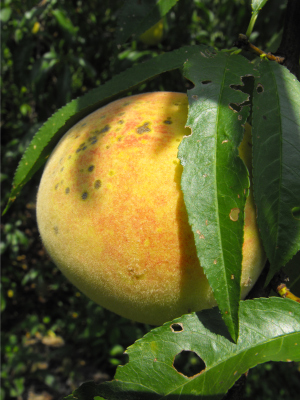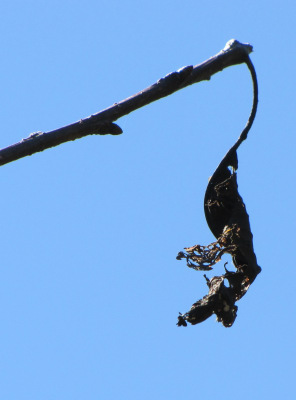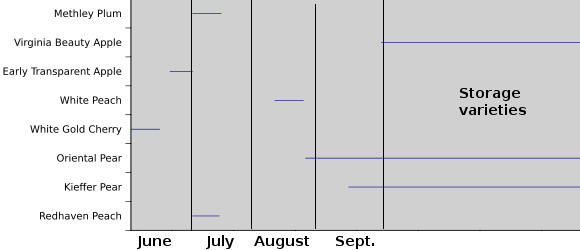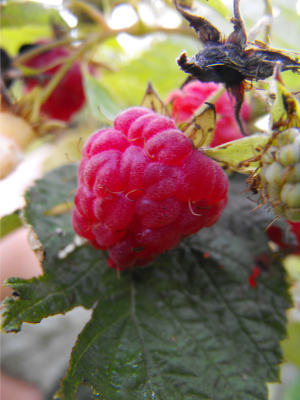
Planning a homestead orchard
 After
researching fruit growing for a decade, I moved to the farm and quickly
discovered how much I didn't know. I've written previously about
how our heavy clay soil with high groundwater requires that we plant our
fruit trees on mounds --- learning that set us back about two
years. But what I want to talk about in this post is how to
choose a combination of fruit trees that will keep you fed throughout
the year.
After
researching fruit growing for a decade, I moved to the farm and quickly
discovered how much I didn't know. I've written previously about
how our heavy clay soil with high groundwater requires that we plant our
fruit trees on mounds --- learning that set us back about two
years. But what I want to talk about in this post is how to
choose a combination of fruit trees that will keep you fed throughout
the year.
Once I found the right
farm, the young, exuberant, farmer-wannabe Anna browsed the catalogs
and
gleefully picked out my favorite fruit varieties. Now, I'm not
going to tell you to plant a variety you don't like, but there's a lot
more to planning a homestead orchard than planting Stayman Winesaps
because that's the kind of apple you've always bought in the
store. Our Stayman Winesap tree will be hitting the burn pile
this
winter because it is so sensitive to the Cedar
Apple Rust that
there's no point in even trying  to
grow a Stayman here with organic
methods. Similarly, the self-pollinating, white dwarf cherry I
was so sure would start producing fruit in 2009 gets so
badly defoliated by Japanese Beetles every year that it may never give
us a
cherry --- I'm going to experiment for another year or two before I rip
it out, but I wouldn't say the variety was a good choice.
to
grow a Stayman here with organic
methods. Similarly, the self-pollinating, white dwarf cherry I
was so sure would start producing fruit in 2009 gets so
badly defoliated by Japanese Beetles every year that it may never give
us a
cherry --- I'm going to experiment for another year or two before I rip
it out, but I wouldn't say the variety was a good choice.
One way to find
varieties that will survive your local bugs and
diseases is to check out what kind of fruit trees your organic gardener
neighbors grow. The
apples we scavenged
are from Liberty apple
trees that are never pruned or sprayed, and
yet provide a bountiful crop every year. Not only that, I felt
like the apples were tastier than storebought Stayman Winesaps --- a
Liberty apple will definitely be making its way into our garden this
winter.

 I
also didn't put enough thought into spreading our ripe fruit throughout
the year. I learned with our mature peach this year that I
wouldn't want to have more than one tree in full fruit during any
given week --- it just takes a lot of time to process that
bounty. On the other hand, if you're like me and think that the
only real way to eat fruit is
fresh, you'd better fill in all of those gaps so that you don't spend a
month in August wishing you had fresh fruit. Although our vine
and bush fruits bear relatively continuously through the growing
season, I'd still like to add in a late July and early August fruit
tree, replace our problematic cherry with a different early fruit,
plant a mid-season apple tree to feed me before the pears fully ripen,
and perhaps expand our storage apple selection to keep me in fresh
fruit through the winter.
I
also didn't put enough thought into spreading our ripe fruit throughout
the year. I learned with our mature peach this year that I
wouldn't want to have more than one tree in full fruit during any
given week --- it just takes a lot of time to process that
bounty. On the other hand, if you're like me and think that the
only real way to eat fruit is
fresh, you'd better fill in all of those gaps so that you don't spend a
month in August wishing you had fresh fruit. Although our vine
and bush fruits bear relatively continuously through the growing
season, I'd still like to add in a late July and early August fruit
tree, replace our problematic cherry with a different early fruit,
plant a mid-season apple tree to feed me before the pears fully ripen,
and perhaps expand our storage apple selection to keep me in fresh
fruit through the winter.
My final word of wisdom
is --- don't price shop for fruit trees.
I am a skinflint, and have been guilty of picking the cheapest tree
from the cheapest catalog in the past. That's how I ended up with
an unknown white peach after three years of nursing
along what I
thought was going to be a yellow peach. (Luckily, the white peach
was still delicious.) Choosing a fruit tree is a lot like
choosing a spouse --- it will be an integral part of your life for a
long, long time. Choose quality.
I'm still barely a
seedling in a tree's eyes, so I'm sure I have a lot
more to learn. What other pitfalls would you point out for a new
orchardist to sidestep?
Want more in-depth information? Browse through our books.
Or explore more posts by date or by subject.
About us: Anna Hess and Mark Hamilton spent over a decade living self-sufficiently in the mountains of Virginia before moving north to start over from scratch in the foothills of Ohio. They've experimented with permaculture, no-till gardening, trailersteading, home-based microbusinesses and much more, writing about their adventures in both blogs and books.
Want to be notified when new comments are posted on this page? Click on the RSS button after you add a comment to subscribe to the comment feed, or simply check the box beside "email replies to me" while writing your comment.

The old fashioned winesap is also supposed to be more resistant to the Cedar Apple Rust, and I believe is a storage apple, right? I'm thinking of hunting one of those down, along with a Liberty apple. Since I do love my peaches, I'm thinking of adding in a midseason peach (or two) to fill my gap, then maybe seeing if I can find a late peach that bears after my white peach.
Our grapes are actually just now getting ripe too, and if our hardy kiwis work out they'll be getting ripe at this time. But I'd like to be doubled up on fruit all through the growing season --- one tree fruit ripe along with my vine and bush fruit at any given time. That way, if something fails, I'll still be swimming in fruit. Now I just have to find room for all of those new trees.
You alluded to it when you mentioned that you learned that you had to plant your fruit trees on mounds. One of the most critical things for the health of the tree occurs before it even goes into the ground. Here are just a few things that come to mind...
Select a location that gets plenty of sun and access to water. I have seen many fruit trees that don't produce because they are overshadowed from larger shade trees or tucked behind a building most of the day.
Dig a hole taking into account how big your tree will eventually grow and then fill with excellent soil, not just the heavy clay soil that you pulled out of the hole. This may seem like overkill, but if you get a stronger, more productive tree, this initial investment will pale in comparison to the difference in yields.
In arid locations or with clay soils, you may even consider burying a pipe that reaches the bottom of the hole, extending a few inches above the top of the soil. This allows you to get water and fertilizer directly to the roots where they can get the most benefit instead of losing that benefit into the surrounding soil and nourishing your weeds.
Daddy --- but I don't remember them. How did they taste?
David --- Very good points. The only place I'd disagree somewhat is your second recommendation. I've read that it often isn't a good idea to add a lot of good quality soil to the hole you dig for a tree (although I have a hard time resisting the urge.) Scientists have dug trees back up years later to look at their root systems and discovered that trees with lots of yummy stuff in their holes tend to keep their roots in that hole rather than venturing further afield. It's next to impossible to improve all of the soil your tree should be reaching into, so those scientists recommend that you don't make the soil your tree starts out in too good if the surrounding soil is poor.
My mounds are in direct contrast to that advice, but I also try to expand the mound every year, adding rotted weeds from the garden around the mound's edges. That gives my trees more good soil to grow into, and I hope they also reach beyond the mounds. And it certainly worked with my first peach tree!
While it's good to buy quality named varieties for the fruit you'll be depending on, it is also fun to plant seeds and strike cuttings of all sorts of fruit and nut trees/plants, if you have the space.
If you source cuttings locally from friends and neighbours, then those trees should do well in your area.
I often plant seeds from store- (or market-) bought fruit - things like peaches, nectarines, apricots, loquats, avocadoes, mangoes, custard apples, pawpaws, pomegranates, etc. It's fun to see what comes up, and it doesn't cost you anything so there's nothing to lose!
I didn't amend the soil (much) around our fruit trees for the same reason, Anna. It's on a windy hillside and I want those trees super anchored!
What I have learned is to dig the hole before the tree arrives, so I can just pop it into the ground, and to continue my double deep square holes. I did that on the blueberries but my helper didn't do it on the trees and it's kinda sucky. The blueberries sit about 5" below grade (on the same hill) and it's so much easier to give them a good drink of water because there's no runoff. I'm dealing with the tree issue by deep mulching with compost & straw. The water seems to get where it needs to go without runoff.... and nutrients are added to the soil each time I water.
My clay drains well and is well above the water line.
Very smart to do your preparation before the tree arrives! When I have my act together I do that, although I still like to soak the roots overnight to rehydrate them from their difficult journey.
I like your idea of sinking the trees into the ground on a hillside. You might consider something like Central American cepas for the trees that didn't get a hole.
We are north of Roanoke,VA. One way of finding/getting good apples for your area, that fit your area and climate, and is more disease resistant, is to take a summer drive on some back roads and see what the farmers have in their fields going to waste. We were driving a back road and found a tree overhanging the road with windfall. We stopped and tried one. It was a bigger Granny Smith with a more robust flavor. We picked up a bushel of apples off the roadside (some WERE bruised). I took one to an 80 year old neighbor/friend. He said it was an Old Smokehouse Apple. He said everyone used to grow them. They are good fresh eating, cooked, baked, canned, etc. A good, general, all-purpose apple. An heirloom type. We canned most of them. My point is: This tree is a fence line tree overhanging the road, cuttings would be no problem. And it would be adapted to your area! We saw probably hundreds of trees out in the pastures. They were cattle feed. Some of these trees were probably over a hundred years old and a lot were in bad shape. If they were there, someone a hundred years ago thought it was a good apple. Good for something. And it has survived, so it must be hardy and disease resistant. Find a field with apples and stop and ask Old McDonald for a taste (and cutting). Do a field taste and see if it meets your needs. You don't need to know its name (Old McDonald probably won't know its name). You get to have a nice drive and get to bring home some new friends (and maybe some new apples). All for the cost of fuel.
As for planting, try as they may, no one has yet improved upon Gods way. Stay away from dwarf, etc. Yes, you will need root stock, but stay standard. If you want dwarf size, trim them short. You will have more root per branch and better apples, better wind resistance. Trim to get what you want, especially air flow. And in twenty, thirty, fifty years, you don't want to have to be out there all winter trimming and tying, etc. to get these non-standard shapes (even if you are able to get around). Plan for the long term and think of your abilities then. If you have to wait an extra year or two for fruit, it is worth it in the long term. You have seen them in the field and tasted them. You know what is waiting you. This other stuff doesn't have the roots to pull up the flavor you want and expect.
Don't give up on your project and enjoy life. You only get one run.
Ralph in Roanoke area